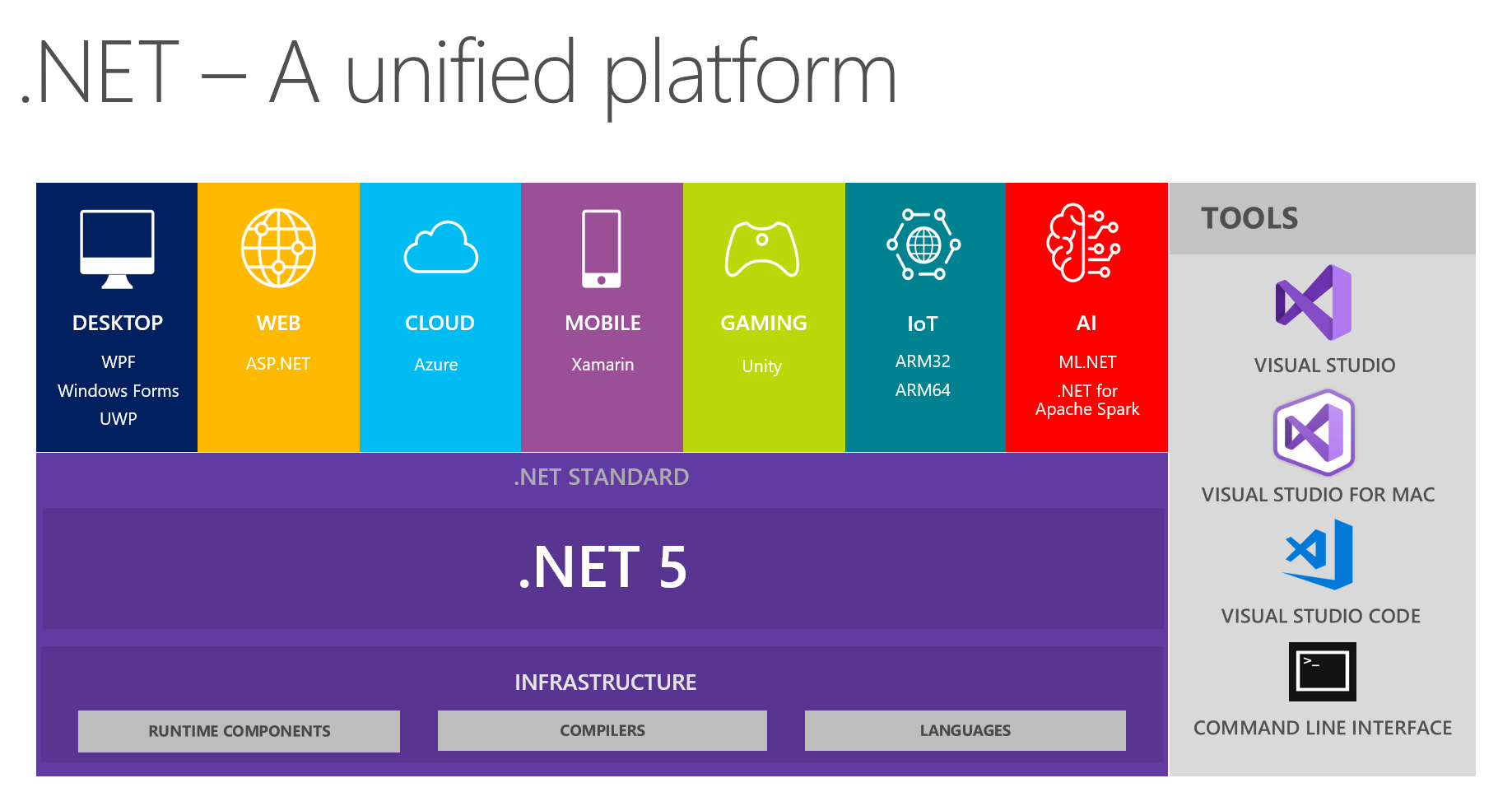The History and Development of .NET
When you first start exploring the .NET technology, you may feel just as overwhelmed as I did with terms like .NET Framework, .NET Core, .NET 5, and a plethora of other concepts such as Mono, Xamarin, and ASP.NET showing up when you open Visual Studio. This article aims to help you gain a basic understanding of these technologies and make sense of the jargon.
Introduction
.NET technology offers developers a comprehensive framework for building and running applications on Windows, Mac, Linux, iOS, and Android. .NET is a platform for creating web-based applications, services, libraries, and interactive experiences. It is used for developing applications for Windows, web, mobile, gaming, and more. Microsoft created .NET in 2002 as a platform for building software applications and services on the Windows operating system.

The .NET technology has evolved through various iterations, with different branches such as .NET Framework, .NET Core, and Mono, each catering to specific needs and platforms.
.NET Framework - Microsoft's original framework for building Windows applications, web apps, and services. It has gone through numerous updates and spanned several versions, with 4.8 being the last major release.
.NET Core - A newer, cross-platform, open-source framework, built with flexibility and modularity in mind. It enables developers to create applications for Windows, Linux, and macOS using a single codebase. The last stable version of .NET Core is 3.1.
Mono - An open-source implementation of Microsoft's .NET Framework, designed to run on platforms such as Linux, macOS, and BSD. It also powers Xamarin in creating native mobile applications for Android and iOS.
To address the need for unification, .NET 5.0 was introduced as the next major release, combining the best aspects of .NET Core, Mono, and Xamarin. It was released in November 2020 and aimed at helping developers build more reliable, secure, and performant applications. .NET 5.0 marks a significant milestone to create a modern, unified platform for software development.
.NET Framework
The .NET framework is a software development platform created by Microsoft and released in 2002. It was originally developed as a successor to the Windows-only family of languages such as Visual Basic, Visual C++, and C#. The .NET framework is a managed runtime environment that provides developers with a comprehensive set of tools and services for creating highly efficient and reliable applications.
Since its initial release, the .NET framework has undergone significant evolution, with multiple versions of the framework being released over the years. The first version of the .NET framework, .NET Framework 1.0, was released in 2002. It was designed to be a comprehensive programming platform that was capable of running applications written in multiple languages, including Visual Basic, Visual C++, and C#. With .NET Framework 1.0, developers were able to create applications that could be deployed on multiple platforms without having to rewrite the code.
The last major version of the .NET Framework is 4.8, which was released in April 2019. The reason there are no subsequent versions of the .NET Framework is due to Microsoft's decision to focus on a unified platform for development with .NET Core, which offers cross-platform support, better modularity, and open-source development.
The birth of .NET 5 heralds the continuation of the .NET Framework's versioning, while simultaneously announcing that there will be no further new versions of the .NET Framework.
You can check versions of .NET Framework from the download page.
.NET Core
.NET Core is an open-source, cross-platform, and high-performance framework developed by Microsoft for creating modern applications such as web APIs, microservices, and cloud-based solutions. It is a successor to the .NET Framework, designed to address the evolving requirements of modern software development.
Here are the major design goals of .NET Core:
Cross-platform Support: .NET Core was introduced to break free from the Windows-only limitation of the .NET Framework. It enables developers to build and run applications on multiple platforms, including Windows, macOS, and Linux, giving them more flexibility and a broader reach for their applications.
Modularity: .NET Core was designed with modularity in mind, allowing developers to include just the necessary libraries for their specific projects. This leads to leaner applications with smaller footprints, reduced startup times, and better overall performance.
Open-source Development: The .NET Core platform is entirely open-source, giving developers and community members the opportunity to contribute and influence its evolution. This transparent development process brings diverse perspectives and experiences, resulting in a richer and more robust framework.
Performance Optimization: Improved performance is a key design goal for .NET Core. Optimizations in the garbage collection, Just-In-Time (JIT) compilation, and runtime enhancements make applications built on .NET Core faster and more efficient.
Container and Microservices Support: .NET Core was introduced to help developers build and deploy applications using containerization and microservices architecture. This modern approach to application development provides better scalability, maintainability, and robustness, particularly for cloud environments.
To sum up, .NET Core emerged as a result of evolving software development requirements and the desire to create an extensible, cross-platform, open-source, and high-performing framework. It addresses the shortcomings of the .NET Framework and continues to evolve in order to meet the ever-changing demands of the industry.
The last version of .NET Core is 3.1, which was released in December 2019. The reason there are no subsequent versions of .NET Core is also that Microsoft decided to unify the .NET ecosystem with the release of .NET 5.0 in November 2020. This new platform emerged from the convergence of the best features and capabilities of .NET Core, .NET Framework, Xamarin, and Mono.
Mono and Xamarin
The development of Mono and Xamarin have been integral to the history and development of the .NET framework. Mono is an open-source alternative to the .NET Framework, providing a way to develop, use, and share software across multiple platforms with ease. Mono supports various programming languages like C#, VB.NET, and F# and includes a runtime engine and a comprehensive set of libraries for cross-platform application development. Mono was initially released in 2004, with the latest version being Mono 6.12.

Xamarin, on the other hand, started as both a company and a cross-platform app development framework built on top of Mono. It allows developers to create native apps for Android, iOS, and Windows from a single codebase using the .NET framework. Xamarin was released in 2011 and has been a popular choice for mobile development, with the latest version being Xamarin.Forms 5.0. In 2016, Microsoft acquired the Xamarin company, further integrating Xamarin technology into the .NET ecosystem.
Differences and Comparisons
The .NET framework has been around for over 20 years, and its evolution during this time has been remarkable. It has gone from being a Windows-only technology to a cross-platform solution, and it has grown to include a wide range of technologies that work together to form a powerful ecosystem.
.NET framework was the first major version of .NET and was released in 2002. It was designed to run on Windows and was used for developing desktop applications. Since then, .NET Core has been released as an open-source, cross-platform alternative to the .NET framework. It has a smaller footprint than the .NET framework and is optimized for web applications.
.NET 5 is a unified platform for .NET framework, .NET Core, Xamarin, and Mono. It is designed to be a single, unified platform for all .NET development.
Mono is an open-source, cross-platform implementation of .NET that was designed to run on Mac and Linux. Xamarin is a cross-platform development platform that allows developers to create native, high-performance mobile apps for Android, iOS, and Windows.
Here is a table comparing .NET Core, .NET Framework, and Mono:
| Feature | .NET Core | .NET Framework | Mono |
|---|---|---|---|
| Platform | Cross-platform | Windows | Cross-platform |
| Open Source | Yes | No | Yes |
| Target Applications | Web, Cloud, Mobile, Desktop | Web, Desktop | Desktop, Xamarin & Unity integration |
| Performance | High | Moderate | Moderate |
| Containerization Support | Yes | Limited | Limited |
| Modern Language Features | Yes | Limited | Yes |
| SDK-style Project System | Yes | No | Yes |
| Side-by-side Execution | Yes | Limited | Limited |
| ASP.NET | ASP.NET Core | ASP.NET | N/A |
| Community-Driven Development | Strong | Limited | Strong |
.NET 5
.NET 5 was released in November 2020, is a milestone in the .NET ecosystem, as it marks the first version that successfully unifies .NET Framework, .NET Core, Xamarin, and Mono into a single, powerful platform for all .NET development. This fusion is designed to provide developers with a robust, streamlined environment to create applications for various platforms and workloads without the need to juggle multiple frameworks or technologies.

While .NET 5 is undoubtedly the pioneer in bringing all these elements together, it is essential to note that it is not the latest version. Actully .NET 5 is not even a LTS(Long Term Support) version.
You can check versions of .NET from the download page.
Conclusion
In the realm of .NET technologies, numerous terms such as .NET Framework, .NET Core, Mono, and Xamarin have proliferated, causing a considerable amount of confusion due to the numerous initiatives from Microsoft. The .NET platform has encountered various challenges and detours along its path, providing Java with ample opportunities to capitalize on.
Fortunately, with the advent of .NET 5, this fragmentation has been mitigated by unifying all these technologies under one umbrella. As a result, numerous technical terms will eventually become obsolete. Moving forward, .NET development will be able to efficiently compete with Java, as developers can leverage a unified and streamlined platform to build applications with ease.